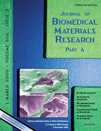Histopathology of the three implanted degradable biopolymers in rabbit eye
Abstract
New straightforward applications of new biopolymers are needed in glaucoma surgery. The aim of this study was to compare biocompatibility of three biomaterials in rabbit eyes after deep sclerectomy; a collagen implant (AquaFlow™) represented the “gold standard”. A blend of 85:15 poly(L-lactide-co-glycolide) and 70:30 poly(L-lactide-co-1,3-trimethylene carbonate) copolymers in a molar ratio of 70:30 (Bio-1 = Inion GTR™ membrane) and poly(DL-lactide-co-glycolide with molar compositions of 50:50 (Bio-2) and 85:15 (Bio-3) were inserted into rabbits eyes. Bio-1, Bio-2 or Bio-3 caused very mild eye irritation or tissue response which was comparable to that of the collagen implant. The biodegradation time of Bio-1, Bio-2, and Bio-3 implants was over one year, 3 months and 6 months, respectively. Implant mapping by Fourier transform infrared (FTIR) microscopy revealed a heterogeneous distribution of degradation products throughout Bio-1, Bio-2, and Bio-3. All implants were surrounded by a very fine tissue capsule which was not visible after total degradation of the implants. The FTIR spectrum of tissue capsule around Bio-1 was almost identical to that around Bio-2 whereas significant differences were observed in the spectrum of the tissue capsule around Bio-3. Despite some differences in tissue response, all tested implants represent biologically acceptable materials for drainage devices in glaucoma surgery. © 2008 Wiley Periodicals, Inc. J Biomed Mater Res, 2009




